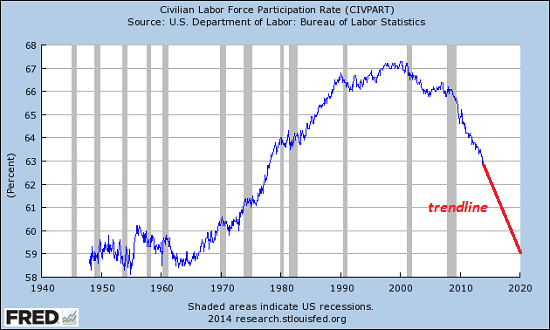March 15, 2014
Despite the Happy Talk, Unemployment Is Still High
Zero Hedge notes that the number of Americans in the labor force has dropped to 1978 levels:
The civilian labor force … dropped from 155.3 million to 154.9 million, which means the labor participation rate just dropped to a fresh 35 year low, hitting levels not seen since 1978, at 62.8% down from 63.0%.And the piece de resistance: Americans not in the labor force exploded higher by 535,000 to a new all time high 91.8 million.
Charles Hugh Smith shows the disturbing trend line:

The mainstream media portrays the cause of this crash as simply being retiring baby boomers, as shown by the following screenshots from a Google search:


 But a February 26 report from the nonpartisan Economic Policy Institute shows this is false:
But a February 26 report from the nonpartisan Economic Policy Institute shows this is false:Since the start of the Great Recession over six years ago, labor force participation has dropped significantly. Most of the drop—roughly three-quarters—was due to the lack of job opportunities in the Great Recession and its aftermath. There are now 5.8 million workers who are not in the labor force but who would be if job opportunities were strong.***More than 70 percent of the 5.8 million missing workers are under age 55.These missing workers under age 55—4.2 million of them—are extremely unlikely to have retired and are therefore likely to enter or reenter the labor force when job opportunities substantially improve.***
The Washington Post noted in January:
The participation rate for workers between ages 25 and 54 fell sharply during the recession and still hasn’t recovered. Obviously, retirements can’t explain this:
 Credit: Calculated Risk
Credit: Calculated RiskSo, what’s going on? One theory is that the weak job market is causing people to simply give up looking for work — they’re crumpling up their résumés and going home. An recent study from the Boston Fed suggested that these “non-inevitable dropouts” might even account for most of the decrease. Among other things, the authors noted that the labor-force decline has been far sharper for all agegroups than simple demographics would predict.***So, why does the size of the labor force matter? If people are leaving the labor force for economic reasons (and they’re not going back to school), it would mean that the economy is in much worse shape than the official unemployment rate suggests. The jobless rate is officially 6.7 percent, but that only counts people who are actively seeking work — not labor-force dropouts. [Remember, you have to include labor-force dropouts in order to arrive at a useful unemployment number.]
In other words, the conventional explanation holds no water.
Despite all happy talk to the contrary, we have a “jobless recovery” – a permanent destruction of jobs – which is a redistribution of wealth from the little guy to the big boys. (And see this.)
No wonder Americans aren’t feeling the love.
And everything the government has been doing since 2008 has made unemployment much worse. And here and here.



No comments:
Post a Comment